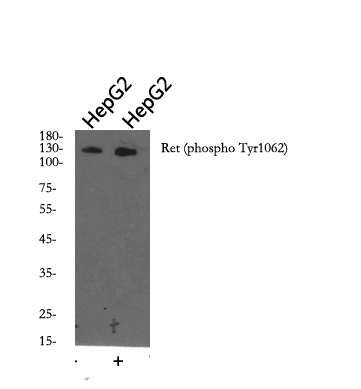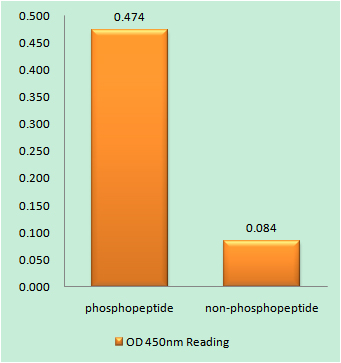
主要信息
Target
Ret
Host Species
Rabbit
Reactivity
Human, Mouse
Applications
IHC, WB
MW
123kD (Calculated)
Conjugate/Modification
Phospho
货号: YP1869
规格
价格
货期
数量
200μL
¥4,680.00
现货
0
100μL
¥2,800.00
现货
0
50μL
¥1,500.00
现货
0
加入购物车


已收藏


收藏
详细信息
推荐稀释比
WB 1:500-2000; IHC 1:50-200
Note:For IHC,wesuggest antigen retrieval with TE buffer pH 9.0 (Cat#YS0004)
Note:For IHC,wesuggest antigen retrieval with TE buffer pH 9.0 (Cat#YS0004)
组成
Liquid in PBS containing 50% glycerol, and 0.02% sodium azide.
特异性
This antibody detects endogenous levels of Ret (Phospho Tyr1096) Rabbit pAb at Human, Mouse.The name of modified sites may be influenced by many factors, such as species (the modified site was not originally found in human samples) and the change of protein sequence (the previous protein sequence is incomplete, and the protein sequence may be prolonged with the development of protein sequencing technology). When naming, we will use the "numbers" in historical reference to keep the sites consistent with the reports. The antibody binds to the following modification sequence (lowercase letters are modification sites):SVyAN
纯化工艺
The antibody was affinity-purified from rabbit serum by affinity-chromatography using specific immunogen.
储存
-15°C to -25°C/1 year(Do not lower than -25°C)
浓度
1 mg/ml
理论分子量
123kD
修饰
Phospho
克隆性
Polyclonal
相关产品
抗原&靶点信息
免疫原:
Synthesized peptide derived from human Ret (Phospho Tyr1096)
展开内容
特异性:
This antibody detects endogenous levels of Ret (Phospho Tyr1096) Rabbit pAb at Human, Mouse.The name of modified sites may be influenced by many factors, such as species (the modified site was not originally found in human samples) and the change of protein sequence (the previous protein sequence is incomplete, and the protein sequence may be prolonged with the development of protein sequencing technology). When naming, we will use the "numbers" in historical reference to keep the sites consistent with the reports. The antibody binds to the following modification sequence (lowercase letters are modification sites):SVyAN
展开内容
基因名称:
RET CDHF12 CDHR16 PTC RET51
展开内容
蛋白名称:
Proto-oncogene tyrosine-protein kinase receptor Ret (Cadherin family member 12) (Proto-oncogene c-Ret) [Cleaved into: Soluble RET kinase fragment; Extracellular cell-membrane anchored RET cadherin 120 kDa fragment]
展开内容
别名:
Proto-oncogene tyrosine-protein kinase receptor Ret ;
Cadherin family member 12 ;
Proto-oncogene c-Ret ;
[Cleaved into: Soluble RET kinase fragment ;
Extracellular cell-membrane anchored RET cadherin 120 kDa fragment]
Cadherin family member 12 ;
Proto-oncogene c-Ret ;
[Cleaved into: Soluble RET kinase fragment ;
Extracellular cell-membrane anchored RET cadherin 120 kDa fragment]
展开内容
背景:
ret proto-oncogene(RET) Homo sapiens This gene, a member of the cadherin superfamily, encodes one of the receptor tyrosine kinases, which are cell-surface molecules that transduce signals for cell growth and differentiation. This gene plays a crucial role in neural crest development, and it can undergo oncogenic activation in vivo and in vitro by cytogenetic rearrangement. Mutations in this gene are associated with the disorders multiple endocrine neoplasia, type IIA, multiple endocrine neoplasia, type IIB, Hirschsprung disease, and medullary thyroid carcinoma. Two transcript variants encoding different isoforms have been found for this gene. Additional transcript variants have been described but their biological validity has not been confirmed. [provided by RefSeq, Jul 2008],
展开内容
功能:
Catalytic activity:ATP + a [protein]-L-tyrosine = ADP + a [protein]-L-tyrosine phosphate.,Disease:Chromosomal aberrations involving RET are a cause of thyroid papillary carcinoma (PACT) [MIM:188550]. Inversion inv(10)(q11.2;q21) generates the RET/CCDC6 (PTC1) oncogene; inversion inv(10)(q11.2;q11.2) generates the RET/NCOA4 (PTC3) oncogene; translocation t(10;14)(q11;q32) with GOLGA5 generates the RET/GOLGA5 (PTC5) oncogene; translocation t(8;10)(p21.3;q11.2) with PCM1 generates the PCM1/RET fusion; translocation t(6;10)(p21.3;q11.2) with RFP generates the Delta RFP/RET oncogene; translocation t(1;10)(p13;q11) with TRIM33 generates the TRIM33/RET (PTC7) oncogene; translocation t(7;10)(q32;q11) with TIF1 generates the TIF1/RET (PTC6) oncogene. The PTC5 oncogene has been found in 2 cases of PACT in children exposed to radioactive fallout after Chernobyl.,Disease:Defects in RET are a cause of congenital central hypoventilation syndrome (CCHS) [MIM:209880]; also known as congenital failure of autonomic control or Ondine curse. CCHS is a rare disorder characterized by abnormal control of respiration in the absence of neuromuscular or lung disease, or an identifiable brain stem lesion. A deficiency in autonomic control of respiration results in inadequate or negligible ventilatory and arousal responses to hypercapnia and hypoxemia.,Disease:Defects in RET are a cause of Hirschsprung disease (HSCR) [MIM:142623]. HSCR is a genetic disorder of neural crest development characterized by the absence of intramural ganglion cells in the hindgut, often resulting in intestinal obstruction. Occasionally, MEN2A or FMTC occur in association with HSCR.,Disease:Defects in RET are a cause of pheochromocytoma [MIM:171300]. The pheochromocytomas are catecholamine-producing, chromaffin tumors that arise in the adrenal medulla in 90% of cases. In the remaining 10% of cases, they develop in extra-adrenal sympathetic ganglia and may be referred to as "paraganglioma." Pheochromocytoma usually presents with hypertension. Approximately 10% of pheochromocytoma is hereditary. The genetic basis for most cases of non-syndromic familial pheochromocytoma is unknown.,Disease:Defects in RET are a cause of renal adysplasia [MIM:191830]; also known as renal agenesis or renal aplasia. Renal agenesis refers to the absence of one (unilateral) or both (bilateral) kidneys at birth. Bilateral renal agenesis belongs to a group of perinatally lethal renal diseases, including severe bilateral renal dysplasia, unilateral renal agenesis with contralateral dysplasia and severe obstructive uropathy.,Disease:Defects in RET are the cause of medullary thyroid carcinoma (MTC) [MIM:155240]. MTC is a rare tumor derived from the C cells of the thyroid. Three hereditary forms are known, that are transmitted in an autosomal dominant fashion: (a) multiple neoplasia type 2A (MEN2A), (b) multiple neoplasia type IIB (MEN2B) and (c) familial MTC (FMTC), which occurs in 25-30% of MTC cases and where MTC is the only clinical manifestation.,Disease:Defects in RET are the cause of multiple neoplasia type 2A (MEN2A) [MIM:171400]; also called multiple neoplasia type 2 (MEN2). MEN2A, the most frequent form of MTC, is an inherited cancer syndrome characterized by MTC, phaeochromocytoma and/or hyperparathyroidism.,Disease:Defects in RET are the cause of multiple neoplasia type 2B (MEN2B) [MIM:162300]. MEN2B is an uncommon inherited cancer syndrome characterized by predisposition to MTC and phaeochromocytoma which is associated with marfanoid habitus, mucosal neuromas, skeletal and ophtalmic abnormalities, and ganglioneuromas of the intestine tract. Then the disease progresses rapidly with the development of metastatic MTC and a pheochromocytome in 50% of cases.,Disease:Defects in RET may be a cause of colorectal cancer (CRC) [MIM:114500].,Function:Probable receptor with tyrosine-protein kinase activity; important for development.,polymorphism:The Cys-982 polymorphism may be associated with an increased risk for developing Hirschsprung disease.,PTM:Autophosphorylated on C-terminal tyrosine residues upon ligand stimulation.,PTM:Phosphorylated.,similarity:Belongs to the protein kinase superfamily. Tyr protein kinase family.,similarity:Contains 1 cadherin domain.,similarity:Contains 1 protein kinase domain.,subunit:Phosphorylated form interacts with the PBT domain of DOK2, DOK4 and DOK5.,
展开内容
细胞定位:
Cell membrane ; Single-pass type I membrane protein . Endosome membrane ; Single-pass type I membrane protein . Predominantly located on the plasma membrane. In the presence of SORL1 and GFRA1, directed to endosomes. .
展开内容
研究领域:
>>Calcium signaling pathway ;
>>Pathways in cancer ;
>>Thyroid cancer ;
>>Non-small cell lung cancer ;
>>Central carbon metabolism in cancer
>>Pathways in cancer ;
>>Thyroid cancer ;
>>Non-small cell lung cancer ;
>>Central carbon metabolism in cancer
展开内容
信号通路
Human Diseases >> Cancer: overview >> Pathways in cancer
Human Diseases >> Cancer: overview >> Central carbon metabolism in cancer
Human Diseases >> Cancer: specific types >> Thyroid cancer
Human Diseases >> Cancer: specific types >> Non-small cell lung cancer
Environmental Information Processing >> Signal transduction >> MAPK signaling pathway
Environmental Information Processing >> Signal transduction >> Calcium signaling pathway
Environmental Information Processing >> Signal transduction >> PI3K-Akt signaling pathway
文献引用({{totalcount}})
货号: YP1869
规格
价格
货期
数量
200μL
¥4,680.00
现货
0
100μL
¥2,800.00
现货
0
50μL
¥1,500.00
现货
0
加入购物车


已收藏


收藏
Recently Viewed Products
Clear allToggle night Mode
{{pinfoXq.title || ''}}
Catalog: {{pinfoXq.catalog || ''}}
Filter:
All
{{item.name}}
{{pinfo.title}}
-{{pinfo.catalog}}
主要信息
Target
{{pinfo.target}}
Reactivity
{{pinfo.react}}
Applications
{{pinfo.applicat}}
Conjugate/Modification
{{pinfo.coupling}}/{{pinfo.modific}}
MW (kDa)
{{pinfo.mwcalc}}
Host Species
{{pinfo.hostspec}}
Isotype
{{pinfo.isotype}}
产品 {{index}}/{{pcount}}
上一个产品
下一个产品
{{pvTitle}}
滚轮缩放图片
{{pvDescr}}




















